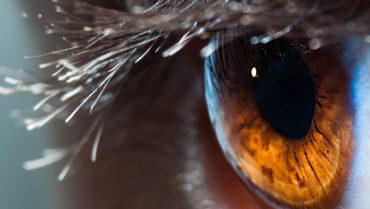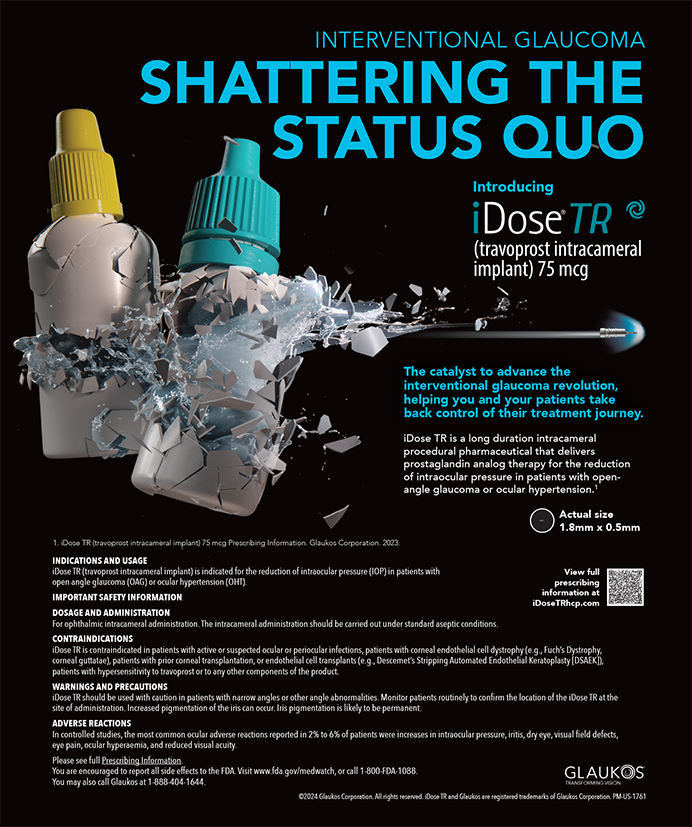Dehydrated amniotic membrane is commonly used during surgeries involving ocular surface reconstruction. Derived from the surface of the human placenta after a healthy birth, amniotic membrane is harvested at tissue banks, where the donor tissue is evaluated for communicable disease. Matching donors to recipients is not necessary, because the donor tissue is absorbed by the recipient through the healing process.
Dehydration allows amniotic membrane tissue to be stored in a shelf-stable state while preserving its active biological components needed for medical uses. Dehydrated amniotic membrane is not freeze-dried, a process that can damage chemical mediators inherent in the material. Instead, it is terminally radiated to sterilize the tissue.
HOW AMNIOTIC MEMBRANE WORKS
Dehydrated amniotic membrane can be used for a variety of applications. The most common is for the treatment of a nonhealing defect on the ocular surface such as a neurotrophic corneal ulcer. Amniotic membrane can also be employed to reduce scar tissue while the ocular surface is healing.
AT A GLANCE
• Dehydrated amniotic membrane is used during surgeries involving ocular surface reconstruction.
• The most common application is the treatment of a nonhealing defect on the ocular surface, but amniotic membrane is also used to reduce scar tissue while the ocular surface heals. For example, it may be indicated in patients at risk of unwanted scar tissue formation such as after pterygium removal.
• Dr. Hovanesian shares some tips for surgeons interested in using amniotic membrane.
When amniotic membrane is used to promote corneal healing, no permanent structure is left behind. Within weeks or months, it melts away and adsorbs. As with many complicated biological processes, how amniotic membrane works to reduce scar tissue is not entirely understood.
PATIENT SELECTION
Amniotic membrane may be indicated in patients at risk of unwanted scar tissue formation, such as after pterygium removal. Among patients at highest risk for pterygium recurrence are men, individuals 40 years of age and younger, those with dark skin, those who have had pterygium surgery previously and had recurrence, patients who have a large pterygium, and individuals who spend a lot of time outdoors.
During surgery, the ophthalmologist removes the pterygium and uses amniotic membrane either as a replacement for the tissue that was removed or as an adjunct to aid healing. The tissue reduces scar formation and promotes healing of the ocular surface. Surgical approaches to pterygium vary from surgeon to surgeon. One approach is the traditional bare sclera technique, in which the growth is removed and the tissue beneath is left uncovered. The problem is that the pterygium frequently grows back. The other popular technique involves a conjunctival autograft, with a piece of tissue from the patient’s own ocular surface. In a related technique, amniotic membrane can be tucked into the subconjunctival space surrounding the conjunctival defect after the autograft is placed. Employing amniotic membrane in any of these configurations can reduce pterygium recurrence.
In 2016, my colleagues and I reported on 100 patients who underwent pterygium surgery.1 We removed the growth, covered it with a conjunctival autograft, and placed a strip of amniotic membrane as a subconjunctival implant underneath the tissues surrounding the graft site. The recurrence rate in these patients was 1%. This technique has had the lowest recurrence rate of any we have used, with and without amniotic membrane, for pterygium surgery. Increasing the technique’s merit is that it adds minimal surgical time and minimal risk for the patient.1
Watch It Now
John Hovanesian, MD, uses an AmbioDisk amniotic membrane disc in a patient with a nonhealing corneal epithelial defect.
Amniotic membrane has also been used with some success over leaking wounds such as full-thickness corneal defects. Usually, it is employed only as a temporizing measure, until a proper patch graft such as donor corneal transplant tissue is available to create a tectonic graft.
Other indications include nonhealing defects of the cornea or conjunctiva, which can occur in patients with rheumatoid arthritis or diabetes, patients with lagophthalmos, or patients with other health conditions that compromise their ability to heal.
NUTS AND BOLTS
When amniotic membrane is used as a substitute for conjunctiva, the surgeon typically glues it into place using fibrin sealant. Alternatively, sutures can be used. Thicker versions of amniotic membrane are necessary when suturing (as in a lid reconstruction procedure), because thicker material allows the suture to be secure.
In nonhealing corneal defects, the amniotic membrane is generally secured under a bandage contact lens. The Kontur contact lens, which is packaged with AmbioDisk amniotic membrane (Katena), is placed on the cornea after the amniotic membrane. The contact lens is typically of large diameter, between 16 and 18 mm.
GETTING STARTED
To begin using these products, surgeons can obtain information about them online. For example, Katena has a library of learning materials that teach surgical techniques related to using dehydrated amniotic membrane. My own website, www.harvardeye.com/services/specialty-eye-care/pterygium, also has videos that can provide an introduction to surgical techniques for amniotic membrane.
In my experience, amniotic membrane products offered by various companies are similar in quality. Available in several shelf-stable forms, the materials come in varying thicknesses to suit different applications and surgeon preferences. It is important for surgeons to seek out products that have physical materials with which they are comfortable.
Typically, the ophthalmologist should not need to obtain additional instruments to perform amniotic membrane surgery; standard ocular surgery instruments should suffice.
ALSO NOTABLE
Amniotic membrane was first used in eye care 50 years ago. Today, it is used for wound healing in many areas of the human body, for instance as an adjunct to other wound-healing techniques in patients with diabetic ulcers and decubitus ulcers.
Amniotic membrane is also used in prenatal surgery on fetuses developing in the womb. The value of amniotic membrane was recognized when newborns were delivered without scarring after such surgery. This experience speaks volumes about amniotic membrane’s powerful wound-healing properties. Something about amniotic membrane provides a protective effect on healing tissues.
1. Shusko A, Hovanesian JA. Pterygium excision with conjunctival autograft and subconjunctival amniotic membrane as antirecurrence agents. Can J Ophthalmol. 2016;51(6):412-416.




